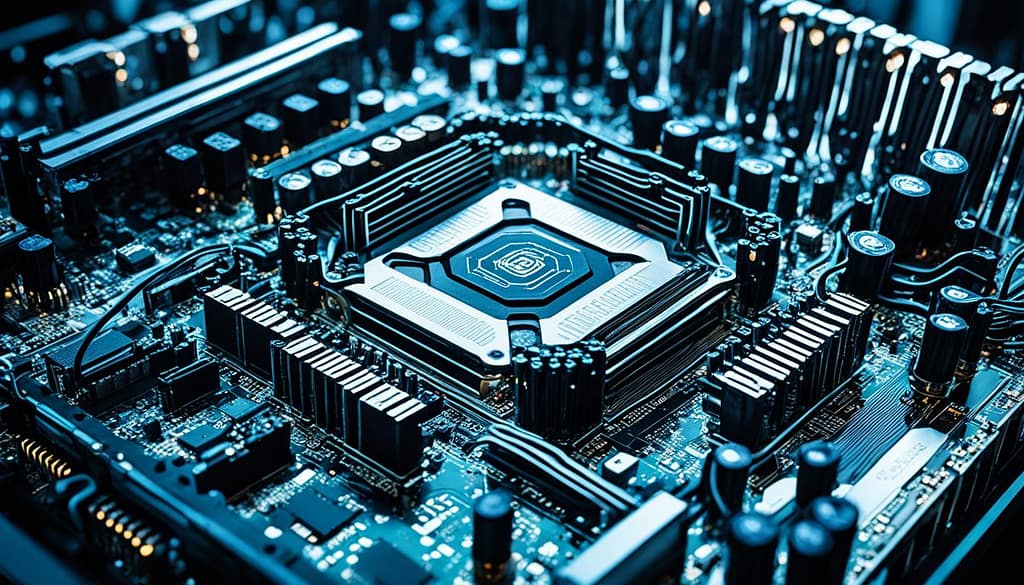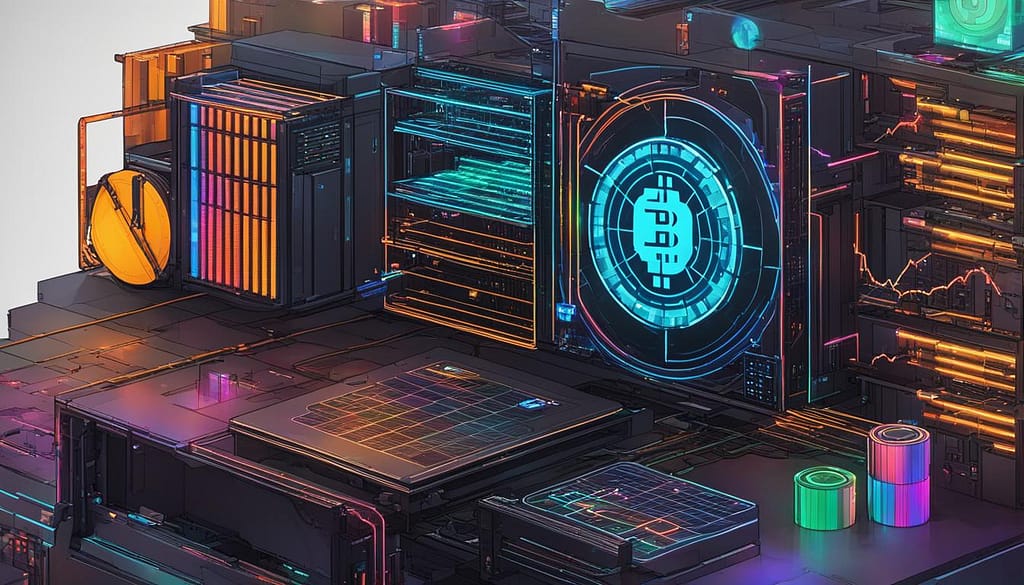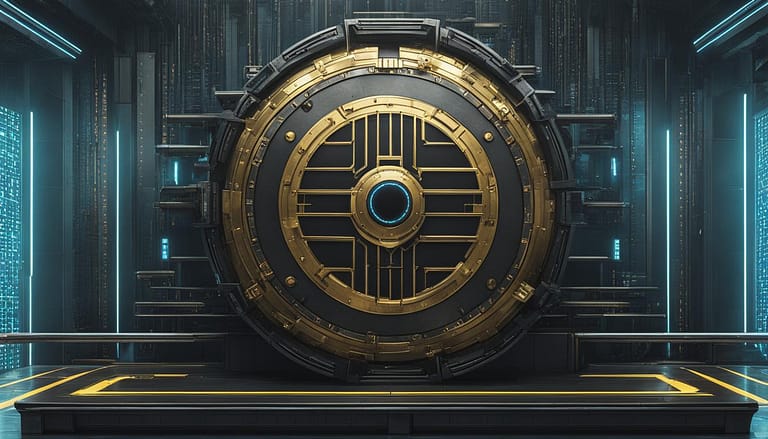An Introduction to Mining Cryptocurrency
The digital gold rush of cryptocurrency mining has soared from niche to a global phenomenon, especially as we near its 10-year milestone. What began as a pursuit for the tech-savvy few has burgeoned, with the scarcity and skyrocketing prices of Nvidia and AMD graphics cards bearing testament to this burgeoning industry. For those enticed by the allure of digital currencies and pondering how to start cryptocurrency mining, it is more than creating virtual wealth; it’s about buttressing a financial revolution.
With its foundations deeply rooted in both complex computational realms and intricate financial systems, cryptocurrency mining stands at the convergence of these worlds. It leverages advanced hardware, including GPUs and mobile devices, to unravel mathematical conundrums and ratify crypto transactions, consequently minting new coins. This endeavour is not for the faint of heart, demanding a nuanced understanding of the craft, referred to as Cryptocurrency Mining Basics.
Key Takeaways
- Evolving from obscurity to wide recognition, cryptocurrency mining is integral to digital currency creation and transaction security.
- The escalation in mining has transitioned from general-purpose consumer graphics to specialized hardware and platforms.
- Understanding the intricacies of Cryptocurrency Mining Basics is vital for anyone venturing into this digital endeavour.
- Securing crypto transactions and maintaining the network integrity form the crux of the mining process.
- Insights on how to start cryptocurrency mining can empower enthusiasts to join the evolving landscape of digital currencies.
- Today’s mining landscape requires both a technological and financial acumen, as it involves high-end hardware to enterprise.
Deciphering the Hype Around Crypto Mining
The world of cryptocurrency mining is as intriguing as it is complex, captivating individuals and investors with the allure of digitized profit. With a surge in understanding cryptocurrency mining algorithms, a mounting number of enthusiasts are exploring the intricate processes that power the blockchain. Gone are the days where an average computer could mine Bitcoin; contemporary mining operations demand specialized Application-Specific Integrated Circuit (ASIC) hardware, though alternative cryptocurrencies, often referred to as “altcoins,” remain accessible for those with standard consumer hardware.
To fully comprehend the mechanisms behind crypto mining, it’s essential to grasp its dual function: Mining stands not only for the creation of new cryptocurrency tokens but equally for the critical task of transaction verification. Each verified transaction fortifies the blockchain, reinforcing the decentralized nature that is the cornerstone of cryptocurrency’s appeal. For a beginner’s guide to cryptocurrency mining, one must first acknowledge the role their hardware plays in this expansive digital ecosystem.
| Cryptocurrency | Hardware Required | Mining Function |
|---|---|---|
| Bitcoin (BTC) | ASIC Miner | New Coin Creation & Transaction Processing |
| Ethereum (ETH) | GPU Rig | Smart Contract Execution & Block Validation |
| Litecoin (LTC) | ASIC Miner or GPU Rig | Scrypt Algorithm Solving & Payment Verification |
| Monero (XMR) | CPU or GPU Rig | Privacy-focused Cryptography & Ring Signature Verification |
As the table illustrates, mining involves an intertwined relationship between chosen cryptocurrency and the appropriate hardware, with each pair working in tandem to uphold and enhance the blockchain’s security and efficiency. Yet, the increasing difficulty of mining algorithms and the competition within the mining community often predicate investment in top-tier hardware for any viable return.
- ASIC Miners: Lauded for their speed and efficiency in mining specific cryptocurrencies such as Bitcoin.
- GPU Rigs: Preferred for their versatility, able to mine multiple types of cryptocurrencies and uphold various network functions.
- CPU Mining: Although largely overshadowed by ASIC and GPU mining, it remains a point of entry for novice miners focusing on less competitive cryptocurrencies.
To navigate the competitive landscape of crypto mining, discovery and adaptability become key. From the coins selected to the mining method employed, each decision influences the journey through the evolving panorama of digital currency production.
Understanding the Blockchain’s Role in Cryptocurrency
The blockchain represents the foundational technology behind cryptocurrencies – a digital ledger that is secure, immutable, and decentralized. Every transaction within this system is heavily encrypted and compiled into a block. Once the block reaches its capacity for transactions, it is sealed and subsequently linked to the chain of previous blocks, creating an unbreakable chain of transaction history. This is where mining with high-end computer hardware becomes essential. Miners utilize powerful GPUs or ASICs to decipher the complex cryptographic equations that the blockchain networks present. It is a highly competitive and resource-intensive process, but one that is critical to the validation and recording of transactions.
Yet, mining’s role in the ecosystem of cryptocurrency extends beyond transaction processing. These digital miners contribute significantly to maintaining and fortifying the network’s integrity. They stand as the first line of defense against fraudulent activity by ensuring that each transaction is authentic and that no single entity can alter the blockchain retrospectively. This is especially crucial in a decentralized system where no single authority governs the ebb and flow of the digital currency markets. The reward for their efforts? Miners receive newly minted coins as well as transaction fees, thus expanding the circulating supply of the cryptocurrency.
- Secure Transactions: Miners fortify the blockchain by validating every transaction through complex puzzle-solving.
- Blockchain Growth: With each block mined, the blockchain perpetually extends, strengthening the ledger.
- High-End Tech: Mining with high-end computer hardware is not a mere option but a fundamental necessity to ensure efficiency and profitability in the mining endeavour.
- Decentralization: Miners are instrumental in preserving the decentralized aspect of cryptocurrencies, ensuring no centralized control and thus holding up the libertarian ethos of these digital assets.
- Reward System: The incentive program for miners intrinsically controls the issuing of new coins, carefully aligning with the inherent scarcity designed within the cryptocurrency’s protocol.
The mining process is undoubtedly intensive, both in terms of computational power and energy consumption. This demand is why only the most advanced computer hardware can execute the mining process effectively. Illustrative of technological prowess, these hardware systems are a testament to the lengths that the industry has progressed and the unyielding growth of the cryptocurrency sector. As we step into a future where digital currencies play a significant role, understanding, and appreciating the intricate work of mining and the steadfast reliability of the blockchain is both fascinating and paramount to grasping the full picture of digital finance.
Breaking Down How Mining Works
Delving into the world of cryptocurrency requires a fundamental understanding of the mining process. In essence, this involves two critical components: cryptocurrency mining equipment and cryptocurrency mining software. Both work in tandem to validate and secure transactions on the blockchain, which is the cornerstone of any cryptocurrency system.
What Does Mining Involve?
Mining is essentially the engine room of the cryptocurrency world. It uses computational power to solve complex cryptographic challenges. These solutions then validate blocks of transactions and sustain the blockchain’s integrity. A successful miner is rewarded with cryptocurrency, but the process demands the right hardware and rewards technical prowess and a savvy choice of software.
The Mining Ecosystem and Transaction Verification
Mining’s purpose isn’t solely to generate new coins—it serves the critical function of verifying the legitimacy of transaction data. As such, every miner is a gatekeeper, ensuring the blockchain ecosystem is secure from fraudulent activities. But with great power comes great responsibility, and maintaining a foolproof system requires adherence to best practices for cryptocurrency mining.
| Cryptocurrency Mining Component | Role | Examples |
|---|---|---|
| Hardware | Solving cryptographic hashes | Specialized GPUs, ASICs |
| Software | Managing hardware operation, connecting to mining pools | CGMiner, BFGMiner, EasyMiner |
| Blockchain | Recording validated transaction data | Public ledgers such as Bitcoin Blockchain, Ethereum Network |
| Miners | Executing proof-of-work, securing network | Independent miners, Mining pool participants |
Investing in top-of-the-line cryptocurrency mining equipment and selecting efficient cryptocurrency mining software are pivotal steps for anyone aspiring to become a successful miner. By following the industry’s recommended guidelines, miners can ensure their operations run smoothly and sustainably.
Cryptocurrency Mining Basics
Embarking on the journey of cryptocurrency mining can seem like navigating uncharted territory for beginners. It intertwines sophisticated technology with strategic resource allocation. Understanding the fundamental components and processes is essential for anyone curious about how to start cryptocurrency mining.
Initially, the mining process could be managed with simple Central Processing Units (CPUs), which are the basic chips in every standard computer. However, the landscape of mining has undergone significant changes. Today, the task requires more powerful tools, namely Graphics Processing Units (GPUs) for some currencies and Application-Specific Integrated Circuits (ASICs) for others, which are designed to handle the copious amounts of data mining demands.
Gone are the days when a solo miner could reap rewards with minimal hardware. The increased difficulty levels of puzzles due to the blockchain’s design has led many miners to join online mining pools. These collaborations allow individuals to combine their computational power, escalating their chances of validating transactions and, consequently, earning cryptocurrency.
For effective mining, a sturdy and unwavering internet connection is as crucial as the mining rig itself. Without connectivity, even the most powerful hardware stands redundant.
Mining pools are not one size fits all, and each comes with its own set of rules, reward systems, and fees. It is prudent for prospective miners to research and select a pool that aligns with their expectations and mining capabilities.
- Understanding hash rates and how they influence earning potential
- Computing the electricity costs associated with continuous mining operations
- Acquiring hardware that balances performance and cost-efficiency
- Continuously learning about cryptocurrency market trends for strategic decisions
In conclusion, the essentials of starting in cryptocurrency mining boil down to the hardware you choose, the mining pool you join, and your continual commitment to staying informed about the dynamic nature of cryptocurrencies.
The Technology Powering Mining Operations
At the core of every cryptocurrency mining operation is a robust technological platform designed to handle extensive computational tasks. Optimizing cryptocurrency mining profitability requires a careful selection of high-end hardware and understanding the cryptocurrency mining basics, which entails not just powerful machinery but also sophisticated software systems.
High-End Computer Hardware Essentials
For individuals intent on establishing a profitable cryptocurrency mining outfit, an advanced GPU setup or ASIC miner forms the crux of the operation. A GPU setup demands a custom motherboard and effective cooling mechanisms, given the intense heat generated during mining. In contrast, an ASIC miner, though a pricier investment, is purpose-built for mining specific cryptocurrencies, thereby offering greater efficiency and improved energy consumption.
Exploring Specialized Mining Rigs
The evolution of the cryptocurrency sector has led to the development of specialized mining rigs. These are not your average PCs; they are meticulously engineered to mine cryptocurrencies with utmost efficacy. Solutions such as HiveOS harness these rigs’ potential, delivering configurations aimed at balancing energy efficiency and peak mining processes.
| Component | Utility in Mining | Notes |
|---|---|---|
| GPU (Graphics Processing Unit) | Calculating complex algorithms | Essential for mining coins like Ethereum; requires a sturdy cooling system |
| ASIC (Application-Specific Integrated Circuit) | Optimized for specific coin mining | More efficient than GPUs but with a higher upfront investment |
| Motherboard | Connecting all mining components | Should support multiple GPUs for scalable operations |
| Cooling System | Maintaining operational temperature | Crucial to protect hardware from heat damage over prolonged mining sessions |
| Mining Software | Interface between hardware and blockchain network | HiveOS, among others, optimizes mining efficiency and eases rig management |
Evaluating Cryptocurrency Mining Profitability
For individuals and entities involved in the cryptocurrency space, understanding the nuances of mining profitability is essential. This evaluation is a multifaceted exercise, considering factors such as the hash rate, power consumption, and the overall costs, which encompass not just the initial outlay on cryptocurrency mining equipment but also ongoing energy expenses.
With the competitive landscape of mining intensifying, alongside significant computational advancements, the task of assessing profitability has become more intricate. Miners have to account for not only the efficiency of their hardware but also the ever-increasing electricity usage directly correlated with the gear’s performance. Strategizing on how to balance these elements is key.
Modern cryptocurrency mining demands a keen eye on both the market trends and the internal dynamics of one’s mining setup to remain financially viable in a space that’s forever evolving.
- The hash rate demonstrates the speed at which a miner can perform the complex calculations required by the blockchain network.
- Assessing power consumption is pivotal, as this is a miner’s primary recurring cost.
- The overall costs must be weighed against potential revenue to discern the break-even point and profitability margins.
Determining the potential profitability of cryptocurrency mining operations also demands staying abreast with the current value of cryptocurrencies, which can fluctuate significantly. Miners must continuously adjust their calculations and strategies to remain profitable amidst these changing conditions. It’s the savvy alignment of potent cryptocurrency mining equipment with intelligent consumption management that could set successful miners apart.
Assessing Different Cryptocurrency Mining Methods
Exploring the landscape of cryptocurrency mining reveals a diversity of approaches tailored to individuals’ technical capabilities and investment preferences. Among these methods, GPU and ASIC mining stand as the powerhouses for those seeking to maximize their mining capacity. However, for those looking towards more communal or less hardware-intensive options, cloud mining and mining pools have gained significant traction. Each method carries its own set of benefits and challenges, guiding miners in their quest to effectively contribute to cryptocurrency networks.
GPU and ASIC Mining
GPU mining harnesses the collective power of numerous graphics processing units to solve complex algorithms, which is pivotal in mining certain types of cryptocurrencies. This method is particularly popular due to the accessibility and versatility of GPUs in mining various digital currencies. Conversely, ASIC mining takes specialization a step further by using hardware designed specifically for mining a particular cryptocurrency, yielding higher efficiency but at the cost of flexibility and potential obsolescence.
Cloud Mining and Mining Pools
Cloud mining offers a unique solution for those reluctant to invest in the expensive hardware often required for cryptocurrency mining. This method allows individuals to rent processing power from cloud-based mining services, enabling them to mine cryptocurrencies without direct hardware management. On the other hand, joining a cryptocurrency mining pool allows miners to combine their computational resources for a greater chance at solving blocks and earning rewards. The collective effort of a mining pool can lead to more consistent payout streams compared to solitary mining ventures.
| Mining Method | Hardware Requirement | Flexibility | Expected Longevity | Profit Distribution |
|---|---|---|---|---|
| GPU Mining | Multiple GPUs | High | Medium | Based on GPU power and mining algorithm compatibility |
| ASIC Mining | Specialized ASIC hardware | Low | Low-Medium (risk of obsolescence) | High yields for targeted cryptocurrencies |
| Cloud Mining | None (remote hardware rented) | Medium | Dependent on service contract | Based on rented hash power |
| Mining Pools | Varies (individual hardware contributed) | Medium-High | High (as pools adapt to new challenges) | Shared proportionally to individual contribution |
As the cryptocurrency landscape continues to evolve, so too does the arsenal of mining methods at a miner’s disposal. Whether prioritizing raw power, flexibility, or cooperative mining, each approach offers distinct pathways to engaging with cryptocurrency networks. Mining pools, in particular, provide a level of shared risk and reward that aligns well with the community-driven spirit inherent in cryptocurrency’s foundations.
Getting Started: Choosing Your Mining Equipment
When it comes to how to start cryptocurrency mining, one of the fundamental steps is selecting the right equipment. Your choice will have a profound impact on the overall cryptocurrency mining profitability. Whether you opt for CPU, GPU, ASIC, or cloud mining will depend on various factors, including not only the initial cost but also ongoing expenses like electricity and cooling systems.
Here’s a guide to help you navigate the complexities and costs associated with each type of mining hardware:
| Type of Mining | Initial Investment | Electrical Costs | Cooling Requirements | Mining Difficulty |
|---|---|---|---|---|
| CPU Mining | Low | Low to Moderate | Low | High (not recommended for competitive cryptocurrencies) |
| GPU Mining | Moderate | High | Moderate to High | Variable (dependent on cryptocurrency) |
| ASIC Mining | High | Very High | High | Low (specifically designed for mining efficiency) |
| Cloud Mining | Variable (subscription-based) | N/A | N/A | Variable (depends on the cloud service provider) |
Remember, the mining difficulties will vary with the dynamics of each cryptocurrency. The goal is to strike a balance between upfront costs and the potential daily returns. It is also imperative to consider the longevity of the equipment and its potential resale value, as the cryptocurrency market is known for fluctuating swiftly.
Finding the right equipment is just the first step in a miner’s journey, but it’s a critical decision that sets the stage for future success. By carefully considering the key factors and costs involved, you can ensure your entry into the world of cryptocurrency mining is both well-planned and informed.
Choosing the Right Cryptocurrency Mining Software
Selecting cryptocurrency mining software is essential for both novice and seasoned miners aiming to optimize their mining operations. The right software not only improves efficiency but also provides stability and the versatility needed to switch between different cryptocurrencies or mining pools. Furthermore, it greatly impacts your ability to manage and monitor your mining activities effectively.
While simplicity might be desirable for beginners, more advanced users may prioritize detailed statistical feedback and comprehensive control over their mining rigs. The landscape of mining software is diverse, with many reputable options available, each with its own unique set of features catering to different types of miners.
| Software Name | Operating System Compatibility | User Interface | Features |
|---|---|---|---|
| CGMiner | Windows, Mac, Linux | Command-Line | Overclocking, Monitoring, Fan Control |
| BFGMiner | Windows, Mac, Linux | Command-Line | Dynamic Clocking, Remote Interface, Mining Pool Hub Support |
| EasyMiner | Windows, Linux, Android | Graphical GUI | Moneymaker Mode, Community Support, Chat System |
| MultiMiner | Windows, Mac, Linux | Graphical GUI | Automated Mining Strategies, Hardware Detection, Remote Rig Management |
Compatibility with your existing hardware and operating system should be your primary filtering criteria. While some software suits a variety of OS types, others are restricted and could hinder your workflow if your system architecture changes. Therefore, it’s imperative to consider long-term usability when making your selection.
Above all, your cryptocurrency mining software should align with your personal mining goals and proficiency, ensuring you consistently accomplish optimal mining efficiency.
Joining a Cryptocurrency Mining Pool
For those looking to delve into the world of cryptocurrency mining, joining a mining pool is often regarded as one of the best practices for cryptocurrency mining. A mining pool represents a synergy of miners who contribute their computing power over a network, to enhance the probability of successfully mining a block on the blockchain. As a miner, you’ll find that becoming part of a mining pool can substantially increase your chances of receiving a return on your investment, while also minimizing the variance in your mining income.
Mining pools operate by pooling resources from individual miners to tackle cryptographic problems together, allowing them to solve blocks more efficiently than they could alone. Rewards are then distributed amongst members, proportionally to the amount of computational power contributed. This collaboration not only amplifies the chance of success for all involved but also serves as a more consistent income stream when compared to the uncertain nature of solo mining.
Successful cryptocurrency mining through pools depends on several key factors, including the pool’s size, the fee structure, and the reliability of the pool’s servers. To facilitate a deeper understanding, analysis of these aspects is outlined below:
| Factor | Details | Impact |
|---|---|---|
| Pool Size | Larger pools boast more consistent payouts but may offer smaller rewards due to the high number of participants. | Smaller rewards are offset by frequent payouts, improving cash flow, which is crucial for covering operational costs. |
| Fee Structure | Pools charge different fees for the services provided. These can be fixed fees or a percentage of the mining rewards. | Choosing a pool with lower fees can significantly increase net earnings from mining. |
| Server Reliability | A pool’s server stability is key to continuous mining operations, securing a lower risk of downtime. | Reliable servers ensure that your mining hardware is constantly at work, maximizing potential earnings. |
It is important to note that while mining pools offer numerous advantages, they also require trust in the pool operators not to cheat or mismanage funds. This makes the reputation of a mining pool a critical consideration before joining.
When selecting a pool, aligning with one that is well-established and demonstrates transparency in reward distribution and governance can help in solidifying a miner’s participation within the cryptosphere. The selection process should encompass an evaluation of the pool’s technical capabilities, customer service responsiveness, and the overall community sentiment surrounding it. Research and due diligence will guide miners to a pool that aligns with their mining goals and ethical considerations.
In essence, pooling resources in the cryptocurrency mining space offers a collaborative way to achieve more predictable and steady returns. It exemplifies one of the core tenets of blockchain tech—decentralization—not only in the validation and transaction process but also in the empowerment it offers to individual miners to compete against more formidable operations.
To conclude, the best practices for cryptocurrency mining include the strategic decision to join a pool. As the crypto market continues to mature, more innovative solutions and pools are likely to arise, giving miners an ever-expanding array of choices to enhance their mining strategy and profitability.
Best Practices for Cryptocurrency Mining
Entering the world of cryptocurrency mining can be as intriguing as it is daunting. To navigate this landscape effectively, it is essential for prospective miners to acquaint themselves with the foundational aspects such as how to start cryptocurrency mining, understanding cryptocurrency mining algorithms, and assimilating a beginner’s guide to cryptocurrency mining. An informed approach to this venture is not only about setting up the right hardware but also entails a thorough comprehension of the cryptocurrency mining basics.
Mitigating Risks and Maximizing Rewards
Commencing a mining operation is an exercise in strategic planning and risk management. Before investing in the necessary hardware or selecting a cryptocurrency to mine, one must conduct a thorough analysis. This includes exploring the legislative environment surrounding cryptocurrencies in one’s region and understanding the tax ramifications of your potential mining rewards. It is critical to keep abreast of how market variables such as reward structures may change, which directly impacts profitability.
Choice of currency and mining equipment should be made with an eye towards long-term viability and potential yield. Efficiency and cost-effectiveness are pivotal, where the decision between hardware options—ASIC (Application-Specific Integrated Circuit), GPU (Graphics Processing Unit), or more standard CPU (Central Processing Unit) setups—becomes critical. To maximize rewards, investing in the most effective technology while managing energy costs is advised, allowing for a more sustainable mining practice.
Sustainable Mining Strategies
The cryptocurrency mining sector is increasingly prioritizing sustainability. This eco-conscious mindset is driving miners and companies alike to tap into renewable energy resources and elect hardware that is energy-efficient by design. Applying these principles is more than an environmental gesture; it ensures the longevity and fiscal health of mining operations.
Integrating sustainability into the core of mining ventures affirms a commitment to global environmental objectives and paves the way for a future where digital currency extraction harmonizes with our planet’s well-being.
Adopting these best practices in cryptocurrency mining—evaluating risks, maximizing rewards through wise investments, and remaining steadfast in pursuing sustainable strategies—will not only bolster the chances of success for individuals but also contribute positively to the broader narrative of cryptocurrency’s role in a flourishing digital economy.
Conclusion
The journey through the intricate world of cryptocurrency mining reveals an ecosystem rich with technical ingenuity and economic opportunity. From grasping the cryptocurrency mining basics to understanding cryptocurrency mining algorithms, it is evident that this activity is a sophisticated blend of science and strategy. Individuals and organizations alike venture into mining, drawn by the allure of contributing to the increasingly significant realm of decentralized finance. Across Canada and beyond, there’s a surge of interest marking this digital pursuit not just as a means of income but also as a commitment to the principles underpinning cryptocurrencies.
Technological advancements over the years have substantially altered the hardware landscape, turning what was once accessible with a standard PC into a domain requiring high-end, purpose-built systems. Each evolution within the industry brings forth new complexities and necessitates a deeper understanding of the mechanisms at play. Yet, these changes also usher in fresh prospects for miners, fostering a dynamic environment where innovation is not only encouraged but essential for success.
As this sector continues to mature, the ingenuity of miners and developers alike will undoubtedly chart the course for the next wave of digital currency extraction. Embracing the cryptocurrency mining basics has never been more pivotal as the industry forges ahead, challenging enthusiasts to delve into the foundational aspects and build upon them. With a diligent approach and a penchant for continuous learning, anyone keen on navigating the labyrinth of cryptocurrency mining can discover viable paths worth exploring.
FAQ
What is cryptocurrency mining?
How do I start cryptocurrency mining?
What is the purpose of blockchain in cryptocurrency mining?
What does cryptocurrency mining involve?
How do you verify transactions in cryptocurrency mining?
What are the essential components of high-end computer hardware for mining?
What are specialized mining rigs?
How do you evaluate cryptocurrency mining profitability?
What is the difference between GPU and ASIC mining?
What are cloud mining and mining pools?
How do I choose the right mining equipment?
Which cryptocurrency mining software should I use?
Why should I join a mining pool?
What are some of the best practices for cryptocurrency mining?
How can I mine cryptocurrencies sustainably?
Source Links
- https://www.investopedia.com/tech/how-does-bitcoin-mining-work/
- https://freemanlaw.com/mining-explained-a-detailed-guide-on-how-cryptocurrency-mining-works/
- https://www.forbes.com/sites/jasonevangelho/2018/03/13/mining-101-what-exactly-is-cryptocurrency-mining/










